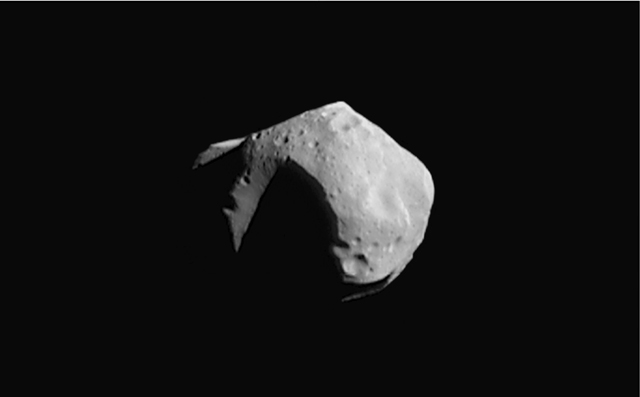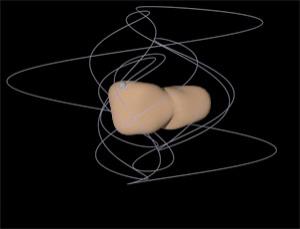我们打算飞到小行星上——但是,哪一颗好呢?
By 苏剑林 | 2010-05-01 | 42303位读者 |站长:已经很久没有翻译过科普文章了。现在再来尝试一下,依旧是“Google+金山+搜索+理解”的模式,依旧是那么烂的水平,依旧是那么差的文采,呵呵。有任何意见欢迎提出。 4月15日,美国总统巴拉克·奥巴马视察了位于佛罗里达州的肯尼迪航天中心并发表演讲,提出美国航天新计划:美国未来航天的目的地是火星和小行星,终止布什政府提出的国家载人航天飞行项目。他强有力地回击了其政策的批评者,同时呼吁私营企业铺设飞往火星的创新之路,而不是以国家之力展示美国的优势。 众所周知,载人登小行星比载人登月难多了。除了苛刻的技术条件外,适合登录的小行星也不多,奥巴马的新方案真的可行吗?让我们拭目以待!
我们打算飞到小行星上——但是,哪一颗好呢?
发送宇航员登录小行星上的方案是完全可行的,但是NASA必须寻找到合适的登录地点,以及解决安全这一问题。
上月,美国总统奥巴马宣布,美国航天局的下一站是小行星,NASA计划在2025年前,将宇航员发送到小行星表面上,为将人类安全送到远离地球的地方积累经验,为火星的漫长之旅铺路。近距离地了解小行星的内陆也具有很大的重要性——或许某一天我们要进行星际移民。然而,这项计划面临着严峻的挑战,如果计划能够成功实施,那么将意味着人类能够克服黑暗冰冷的太空环境。
在登录小行星前,必须先发射宇宙飞船环绕小行星进行探测,而不仅仅是简单地掠过小行星。通过这个途径来获取该项目所需要的信息,如速度、位置等,这些信息帮助决定实施这项计划的火箭适合携带的燃料量。而那些在预定发射时间内最接近地球的小行星将会是发射目标的唯一选择(也就是冲日的位置)。
虽然太空中有很多陨石等小天体,在预定的时间(2025年以及前后的几年之内)里,位置上接近地球的小行星仍然是很少的。马萨诸塞州的剑桥(非英国剑桥大学,这是美国的剑桥)哈佛-史密森天体物理学中心的Martin Elvis,在波士顿的“美国天文学会司天文动态第41届年会”(the American Astronomical Society's Division on Dynamical Astronomy)上对此进行了指出,。
2009年,由NASA约翰逊航天中心的Paul Abell领导的研究发现,在2025到2030年间,《近地天体》(near-Earth objects,陨星学和行星科学,1825年)所列举的1200多颗小行星中,只有7颗适合人类访问。即使算上到2006年为止所新发现的小行星,这个数字也只是增加到42。而且把更进一步的因素考虑进去之后,这些小行星有很多也会被否决。
目前,大多数小行星自转速率仍然是一个未知数,但是任一高速自转的天体都会立即被否决,因为对宇航员来说很难在这些天体上站立着。结合发射延期等可能性,很显然我们需要找到更多的候选天体。Elvis如是说。“我想人们还没有意识到所需要的数量。”他说,“NASA需要勘察大量的小行星,以筛选出最好的一个!”
而Abell乐观地表示,一些大型望远镜,如最近将会在夏威夷落成的Pan-STARRS天文台,将会扩大候选小行星的名单。“将会有很多,很多的探索对象。”他说。
但是,Elvis指出,地面望远镜有很大的限制,因为小行星在轨道上运行,会像地球一样常被太阳的强光淹没了它的光芒。他主张发射一艘空间望远镜到金星附近的太阳轨道上,这样可以更好地观测到近地小行星——这是一个已探讨了很久但都没有资金实施的方案。
博尔德的科罗拉多大学的Daniel Scheeres对运行轨道进行了模拟后表示,就算找到了适合的探索目标,仍然有很多问题需要解决。小而形状不规则的小行星有着块状重力场(如图片),所以探测飞船会进入一个混沌的轨道,使得导航比绕月飞行和绕地飞行更加麻烦。
“有些小行星的表面也可能是不稳固的,因此宇航员可能引发意外滑倒。”Scheeres补充指出明智的做法是在载人登陆之前,先发送机器人上去。 “在发送宇航员之前,我们缺乏必要的数据。”他说。
英语原文:
We're flying to an asteroid – but which one?
DECIDING to send astronauts to an asteroid is all very well, but now NASA will have to find the few space rocks that are suitable to visit, and work out how to rendezvous safely.
Last month, US president Barack Obama announced the next destination for NASA astronauts would be an asteroid, as early as 2025. The goal would be to gain experience of safely sending humans far from Earth, as a stepping stone towards longer journeys to Mars. Studying the interior of an asteroid up close could also prove important if we ever need to deflect one. Yet achieving the goal will mean overcoming daunting challenges.
Before landing on an asteroid, a spacecraft must enter its orbit, rather than simply whizzing by. That means matching the object's speed and direction of motion, which in most cases would require burning too much rocket fuel to be practical. The only way round this would be if the asteroid's motion happened to be very similar to Earth's at the time of its closest approach.
Even if a space rock passes that test, few have close approaches to Earth in the right time frame, in 2025 or the following few years, points out Martin Elvis of the Harvard-Smithsonian Center for Astrophysics in Cambridge, Massachusetts, who was to speak on the subject this week at a meeting of the American Astronomical Society's Division on Dynamical Astronomy in Boston.
A 2009 study led by Paul Abell of NASA's Johnson Space Center in Houston, Texas, found only seven asteroids that could be visited between 2025 and 2030, from a list of more than 1200 near-Earth objects (Meteoritics and Planetary Science, vol 44, p 1825). New discoveries since that study - which only included asteroids known in 2006 - has increased that number to 42, but many of these could be rejected when further criteria are applied.
The rotation rate of most asteroids is unknown, but any fast-spinning objects will be off limits because they would be difficult for astronauts to hang onto. Combine that with potential mission delays, and it becomes clear that many more candidates are required, Elvis says. "I think people have not appreciated how many you need," he says. "NASA will need to survey huge numbers of asteroids to sift out the limited number of really good ones."
Abell is optimistic that telescopes like the Pan-STARRS observatory that recently opened in Hawaii will expand the list of candidates. "There could be many, many targets to go to," he says.
However, ground-based telescopes are hampered because asteroids in orbits similar to Earth's are often hidden by the glare of the sun, Elvis says. He advocates launching a space telescope to orbit the sun near Venus, from which it could look outward to see asteroids near Earth's orbit - an idea that has long been discussed by astronomers but never funded.
Even if enough suitable targets can be found, there are more problems to overcome. Small, irregularly shaped asteroids have lumpy gravity fields, so an orbiting spacecraft would follow a chaotic trajectory, making navigation much trickier than around Earth or the moon, says Daniel Scheeres of the University of Colorado in Boulder, who has simulated such orbits (see picture).
The surfaces of some asteroids may also be unstable, so astronauts could accidentally set off a landslide, Scheeres says, adding that it would be wise to send robots before humans. "We don't have the sort of data that you might want before you send an astronaut," he says.
转载到请包括本文地址:https://spaces.ac.cn/archives/639
更详细的转载事宜请参考:《科学空间FAQ》
如果您还有什么疑惑或建议,欢迎在下方评论区继续讨论。
如果您觉得本文还不错,欢迎分享/打赏本文。打赏并非要从中获得收益,而是希望知道科学空间获得了多少读者的真心关注。当然,如果你无视它,也不会影响你的阅读。再次表示欢迎和感谢!
如果您需要引用本文,请参考:
苏剑林. (May. 01, 2010). 《我们打算飞到小行星上——但是,哪一颗好呢? 》[Blog post]. Retrieved from https://spaces.ac.cn/archives/639
@online{kexuefm-639,
title={我们打算飞到小行星上——但是,哪一颗好呢?},
author={苏剑林},
year={2010},
month={May},
url={\url{https://spaces.ac.cn/archives/639}},
}












May 2nd, 2010
登上火星…我也想
Me,too! ^_^ 人生最大的梦想是参与一次太空游(遥远...)
May 30th, 2010
唉,想去啊没钱!
May 30th, 2010
奥巴马咋把重返月球计划给枪毙了,真是太可惜啦!
我觉得没有什么可惜的,当初月球计划得到重视,是因为它是绝对先进前沿的探索。现在花钱重复当年的往事没有太大意义——更重要的是,没有那么多钱。
May 30th, 2010
的确啊,应该把钱用在有用的地方,现在NASA还要研发下一代载人航天器,资金够紧张的哦。等我们中国人登月的时候那时就知道有没有美国人登月这回事了。